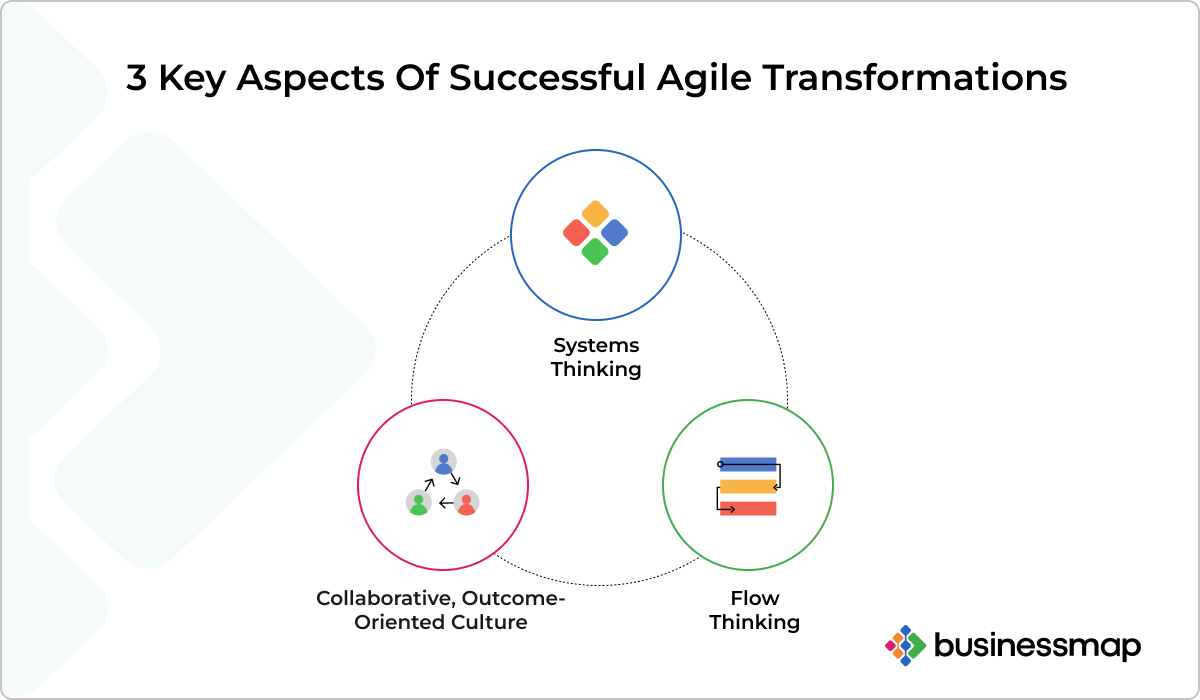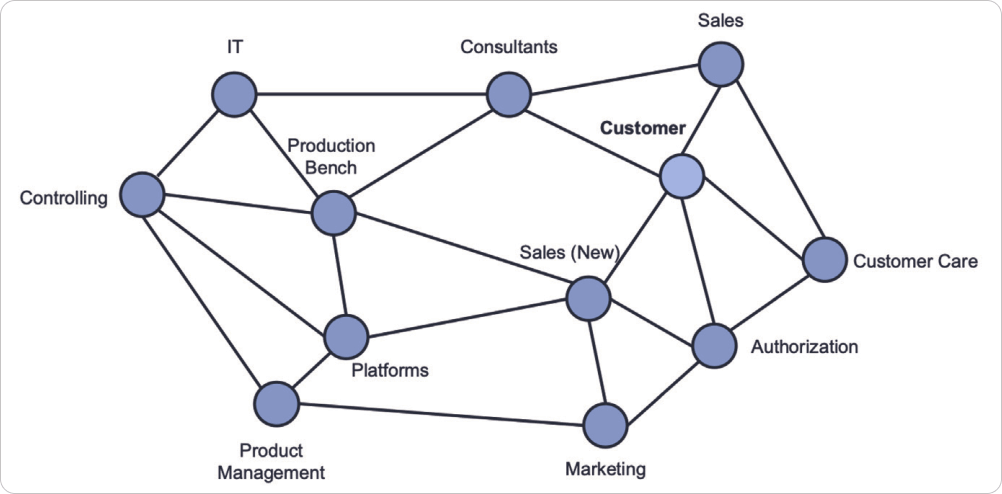"Be the change you want to see in the world."
In the dynamic business landscape, the wisdom of Mahatma Gandhi's famous quote takes on a new meaning: "Be the change you want to see in your organization."
Being adaptable and responsible for change is the new normal. To stay on top of their game, many companies adopt an innovative approach to remain flexible and deliver better business outcomes. Agility is the solution that promises competitiveness and thrives in the face of constant evolution.
In short, agility is no longer a luxury; it's a necessary strategy.
This transformation is full of obstacles, and navigating this critical organizational shift requires strong leadership to avoid ending up in the failure bucket of nearly 70% failed agile transformations.
Follow us to explore the profile of the central figure responsible for guiding and steering the agile transformation process - the agile transformation leader, the individual (or team).
Who Is the Agile Transformation Leader (or Leaders)?
First, one or more individuals may lead an agile transformation, each acting as a change agent to bridge the gap between your current business practices and the new desired way. They are tasked with fostering a culture of agility, driving strategic alignment, and ensuring the successful implementation of Agile practices across the organization.
So far, so good. But is there more to know about this role? Let's find out.
Who's Who in Agile Transformation?
When it comes to a successful agile transformation, the fourth piece of the puzzle, the "WHO" - the individuals responsible for leading this business agility transformation - is just as crucial as the 'Why," "What," 'and "How."
While some might assume that a single "Agile coach" spearheads the entire process, the reality can be more nuanced. The truth is that it mainly depends on the organizational structure and complexity of the organization changing.
Due to the limited scope of the transformation, a single agile transformation leader is more common in smaller companies. This individual takes on the role of a coach and leader, overseeing the entire process. They juggle multiple responsibilities, managing executives and teams and ensuring the smooth progress of the transformation.
It is another story for larger companies with a broader transformation effort.
As you can imagine, more than a single person is needed compared to the scale of this initiative. These organizations often benefit from establishing a dedicated Agile Transformation Office (ATO) or having a group of Agile coaches/ leaders, including personas with different skill sets and responsibilities.
This group of professionals partners with people at all levels to run a successful transformation program. They focus their efforts with executives on strategy, communication, and overall vision, and mid-level managers and team members on coaching Agile essentials.
Here is an example of some specific roles and responsibilities of an agile transformation leadership team provided by LeadingAgile:
| Role | Responsibilities | Competencies | |
| Transformation Lead (TL) |
|
|
|
| Expedition Lead (EL) |
|
|
|
| Program/ Portfolio Coach |
|
|
|
| Agile Process Coach |
|
|
|
| Technical Coach |
|
|
|
| Analyst |
|
|
|
Source: LeadingAgile
Now, remember, these roles are just an example. You may have different roles tailored to your organization's needs. The important thing is having a dedicated team to lead the agile transformation, ensuring focused effort and expertise in guiding the journey toward agile success.
Mid-Level Managers: The Champions of Agile Transformation
Far too many companies fail to grasp the vital role of mid-level managers in the success of an agile transformation. When provided with the proper support and training, mid-level management can become the champions of enterprise agility and add more value than anyone else.
Let me explain why and how.
The why: Mid-level managers bring a unique perspective with their diverse range of capabilities and extensive experience gained through their transition from individual contributors to team leaders. Their deep understanding of operational dynamics, the organization's cultural processes, and practices equip them to provide valuable insights and optimal solutions to various issues.
The how: Mid-level managers play a pivotal role as a bridge, connecting the strategic vision of upper management with the execution activities of team contributors. This unique position allows them to foster cross-functional collaboration, remove roadblocks, and help diverse teams adopt new ways of working faster than usual.
What to do: Equipped with leadership skills and operational expertise, mid-level managers are the hidden gems of organizations willing to shift their culture and adopt business agility. By investing in these leaders with the proper training, resources, and a clear understanding of their evolving role, companies can leverage their experience and leadership to navigate the agile journey toward success.
After all, successful agile transformations require a supportive environment for mid-level managers. Leadership has little to do with specific roles and having control over people. It has more to do with creating leaders to admire and trust, leaders who understand people and influence them to embrace change and do things better.
3 Key Aspects of Successful Agile Transformations
Transforming into an agile organization isn't just about adopting new processes and tools. From our service department's practice, guided by Teodora Bozheva's insights - a celebrated author and speaker in the agile community - we've identified three critical pillars for a successful agile transformation: systems thinking, flow thinking, and collaborative, outcome-oriented culture.

1. Systems Thinking
Systems thinking - the mysterious force that makes agile transformations work like a well-oiled machine rather than a chaotic circus. It's the difference between your agile journey being a smooth sail on a serene lake or a frantic paddle in a hurricane.
In a nutshell, systems thinking is understanding that your organization isn't just a group of different departments that work in the same company but part of a larger ecosystem of interconnected parts.

Systems thinking helps you see beyond the immediate tasks, projects, or sprints, recognizing the wave effects of every change.
But systems thinking reminds us that transforming a single team's workflow without considering the impact on other teams, the technology stack, or organizational culture is like rearranging deckchairs on the Titanic.
2. Flow Thinking
Flow thinking - the magical elixir that turns the messy processes into a smooth value creation chain.
At its core, flow thinking is all about optimizing the movement of work through your system. It's about ensuring that tasks flow smoothly from start to finish without bottlenecks or unnecessary detours.
Flow thinking reminds us to focus on the entire process, identify and eliminate bottlenecks, streamline processes, and maintain a steady, predictable pace. Without flow thinking, your agile transformation might end up like rush hour traffic: a lot of noise, little movement, and a lot of road rage.
3. Grow a Collaborative, Outcome-Oriented Culture
The collaborative, outcome-oriented culture - the magical unicorn every agile transformation needs.
So, why is growing this culture so crucial for agile transformations? First, let's break it down. A collaborative culture means that people talk to each other, share ideas, and work toward common goals.
Teams communicate openly, break down silos, and tackle problems together. It's like upgrading from a chaotic game of telephone to a well-coordinated group chat where everyone's on the same page.
Outcome-oriented means that everyone is laser-focused on delivering real, tangible results. It's not about how many tasks you've completed or how busy you look; it's about the impact of your work. Are you moving the needle? Are you delivering value to customers? If you spend more time perfecting your delivery charts than delivering results, you're missing the point. An outcome-oriented culture keeps your eyes on the real prize: meaningful progress.
Barriers Agile Transformation Leaders Often Bump into
Agile transformations can be exciting journeys but not without their challenges. The reasons why nearly half of the agile transformations fail can vary widely, but a few of the most common obstacles are listed below.
- Little to no leadership participation
Unfortunately, 41% of companies (participating in the 17th State of Agile Report) cited no active leadership participation in the organization's transition to business agility. Leaders at all levels need to buy into this and ask for mentoring and support from the respective professionals to succeed. This requires creating a safe environment where honest and transparent communication is welcomed and mutual trust is built.
- Organizational structure barriers
Rigid hierarchies and siloed departments can impede collaboration and agility. Leaders may need to restructure teams and processes to create a more open and collaborative environment to deliver value and make decisions faster.
- Copy-paste a successful model
No doubt, we should get inspiration from successful agile transformation case studies. However, what works for one will not automatically work for others (take the Spotify model, for example). Every organization is unique, and so is the solution it needs. That said, don't just copy and paste what has been successful. Instead, adopt your transformation following your unique context and use case. Never stop experimenting and continuously improve.
- Lack of understanding and training about Agile
Another alarming statistic is that “37% said business teams simply do not understand Agile is or what it can do, while 27% said there is not enough training.” (source: 17th State of Agile Report)
- General resistance to change
The most common reason agile transformations fail is the widespread resistance to organizational change and cultural clashes. Nearly half of Agile practitioners (47%) believe this is the greatest obstacle to Agile adoption.
A Word from Businessmap (formerly Kanbanize)
At Businessmap, we have witnessed companies undergo incredible transformations across various industries. Companies can unlock new potential and stay competitive by understanding the true meaning of being Agile and fostering a culture of agility. It's a journey that requires time and, most importantly, a collective effort to reshape the traditional organizational structure and operations into a new, result-driven way of working.
We help companies achieve true business agility by providing them with advanced solutions tailored to their unique scenarios. The enhanced program of PPM Ops, designed to help teams and organizations improve their organizational agility, shows spectacular results among organizations worldwide. The program boasts a 92% success rate in helping CTOs, Department Managers, PMO Directors, Program Managers, and Change Agents achieve their initial goals, resulting in a 250% boost in productivity.
Businessmap is the most flexible software, helping your company gain visibility across all projects/portfolios, align on goals, and deliver quality work faster.

Michaela Toneva
Kanban & Agile Practitioner | SEO & Content Creator
With a never-ending thirst for knowledge and a passion for continuous improvement, Michaela is an Agile practitioner with a good understanding of Kanban, Lean, and Agile methodologies. Her professional background includes SEO and content writing with a dose of sales and a pinch of social media.



